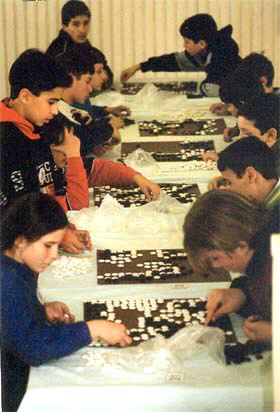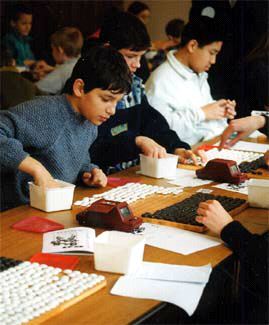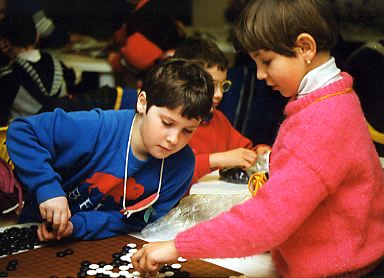 |
|
| Playing by the Ing Rules | |
 |
|
| Playing by the Ing Rules | |
 |
 |
The Mr. Ing's Cup Childen's Go Tournament held in March every year is the only unified go tournament in Europe for children. It's always the event I most look forward to. This year it was held in the old capital of Romania, Sinaia. Participating were 125 children from 11 countries, ranging in strength from 30-kyu to 6-dan. The tournament was held in the midst of snowy scenery for three days, with everyone shrugging off the cold. I'm sure you've all heard of the great Taiwanese industrialist and go fanatic Mr. Ing Chang-Ki (known simply as Ing overseas). He's the sponsor of the Mr. Ing's Cup World Professional Go Championship held every four years. He's also invented his own go rules and made donations all over the world to popularize them and promote their use. He's caused great changes in overseas go. Mr. Ing died several years ago, but his support for go continues unchanged under the conditions of his will. This tournament in Sinaia is the European qualifying tournament for the World Youth Tournament sponsored by Mr. Ing, and this is the fifth year it's been held. I've been taking part since the second year. The venue changes every year, so the line-up of participating countries does likewise. For example, at last year's tournament in Cannes, more than half of the participants were French children, and there were also children from Spain and England etc., but this year there were only eight participants from Western Europe. The host country Romania provided 80 competitors, and there were also large numbers from Eastern European countries such as Russia, the Ukraine, etc. For the children, this tournament is a chance to make new friends through go, as well as a valuable opportunity to polish their skills through serious competition. However, Europe is so vast that travel expenses are nothing to sneeze at, so there are many children who are unable to take part for financial reasons. That's the reason for the biggest problem of this tournament, that the number of competitors is not going up much every year, even though more and more children are learning go. There are two sections in the tournament: under 18 and under 12, with six games being played in each. The top two in the under 12 and the top four in the under 18 are invited to participate in the world championship, scheduled to be held in Prague in July this year. With such an enticing prize, really strong children will travel a long way to take part. However, their fathers and elder brothers really suffer from the tension -- every day they seem to get more and more worn out, whereas the children themselves enjoy renewing old friendships and making new ones. They become more and more powerful every day -- the vitality of youth! Use of the Ing rules is compulsory in the tournament. These are very eccentric rules which would be very difficult for me to explain in prose, but at least I'll try to give an outline. First of all, the komi is eight points. Captured stones are returned to the opponent. After the end of the game, the remaining stones in your go bowl are used to fill in your territory. The side that ends up with most territory left wins. Dame points are also worth one point each, and the game ends when each side passes in succession. For these rules, you have to have exactly 180 stones to start out with, so Mr. Ing developed special go bowls and has donated them around the world. In short, in return for financial assistance, tournament sponsorship, and the donation of go equipment, you have to use the Ing rules. In practice, you have to have the exact number of go stones for each game, so managing this is difficult; in particular, in this respect the rules are not suited to children. On top of this, the specially made plastic go bowls are awkward items with zero aesthetic appeal, and, what's more, they break easily. All one can say, from a Japanese point of view, is that they're better than nothing. However, you're lucky if you actually have go bowls. Half the games at this tournament didn't have bowls, so the stones were in plastic bags. The children would count out the right number of stones on the board, then pile them beside the board where it was easy to push a stone on to the board when playing a move. Go etiquette was out of the question. You can't complain overseas where there's little go equipment and financial assistance. Surely the most important thing is the simple fact that children's tournaments like this even exist and that as many children as possible get to play in them. (To be continued) (June, Monthly Go World) |
|
 |
|
 |
|